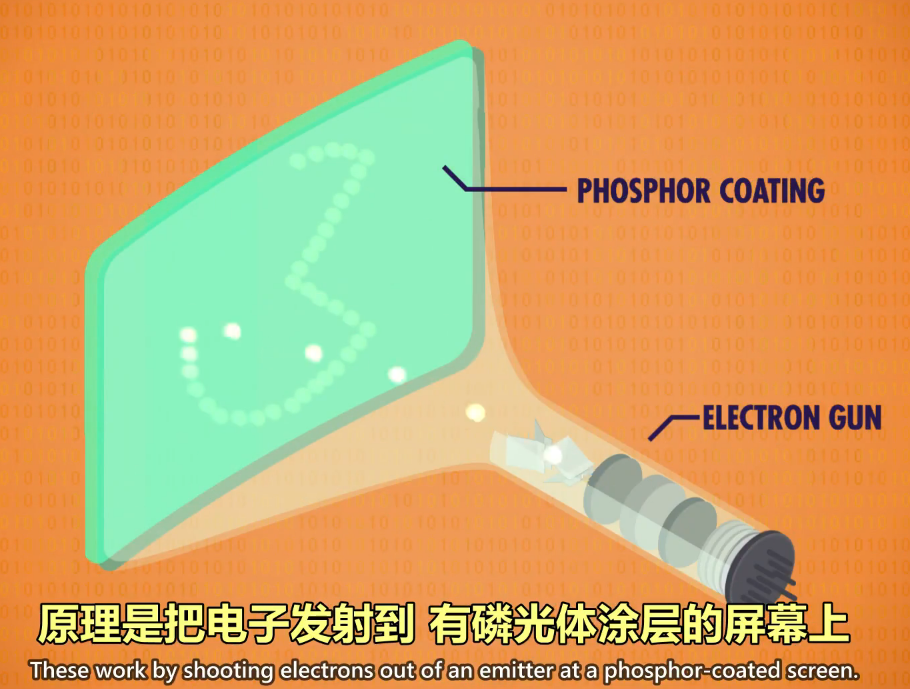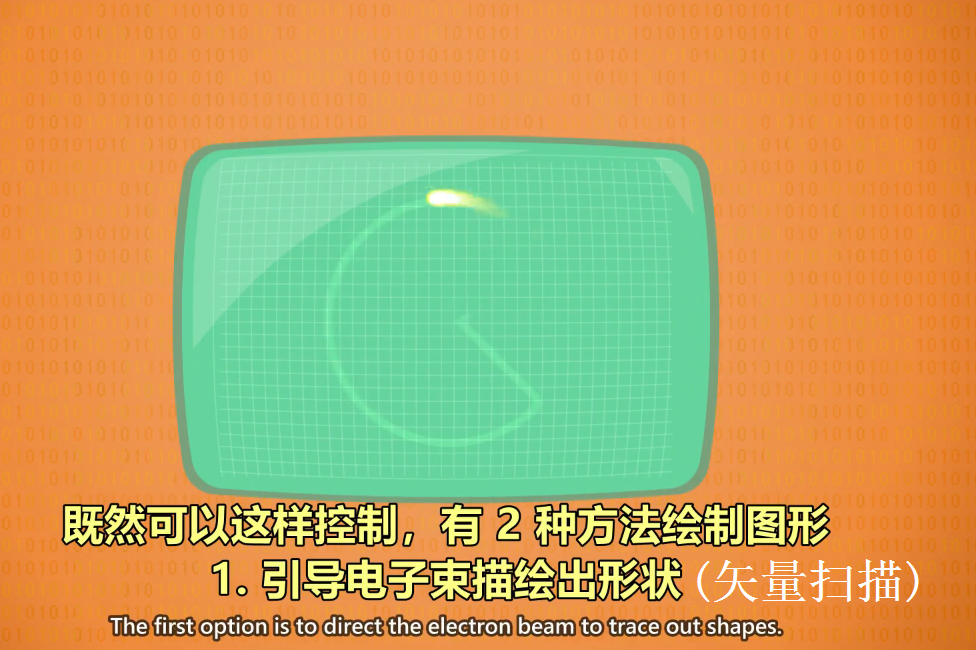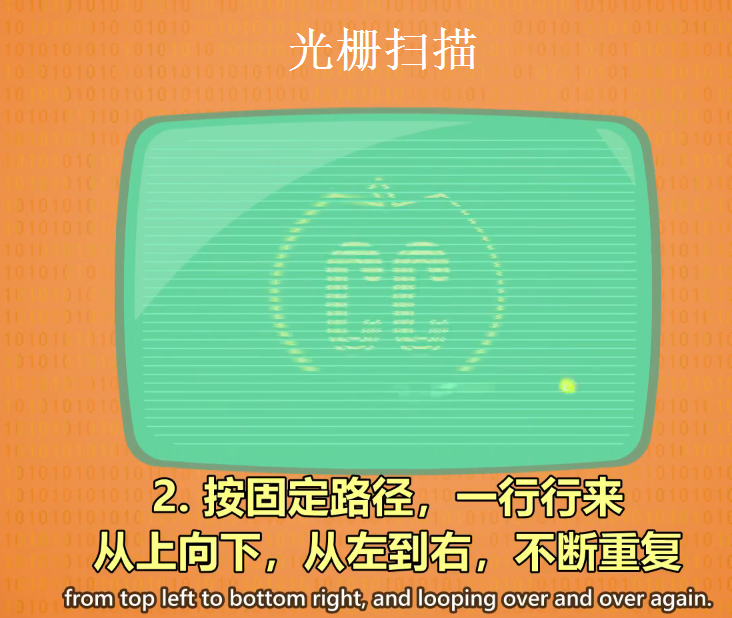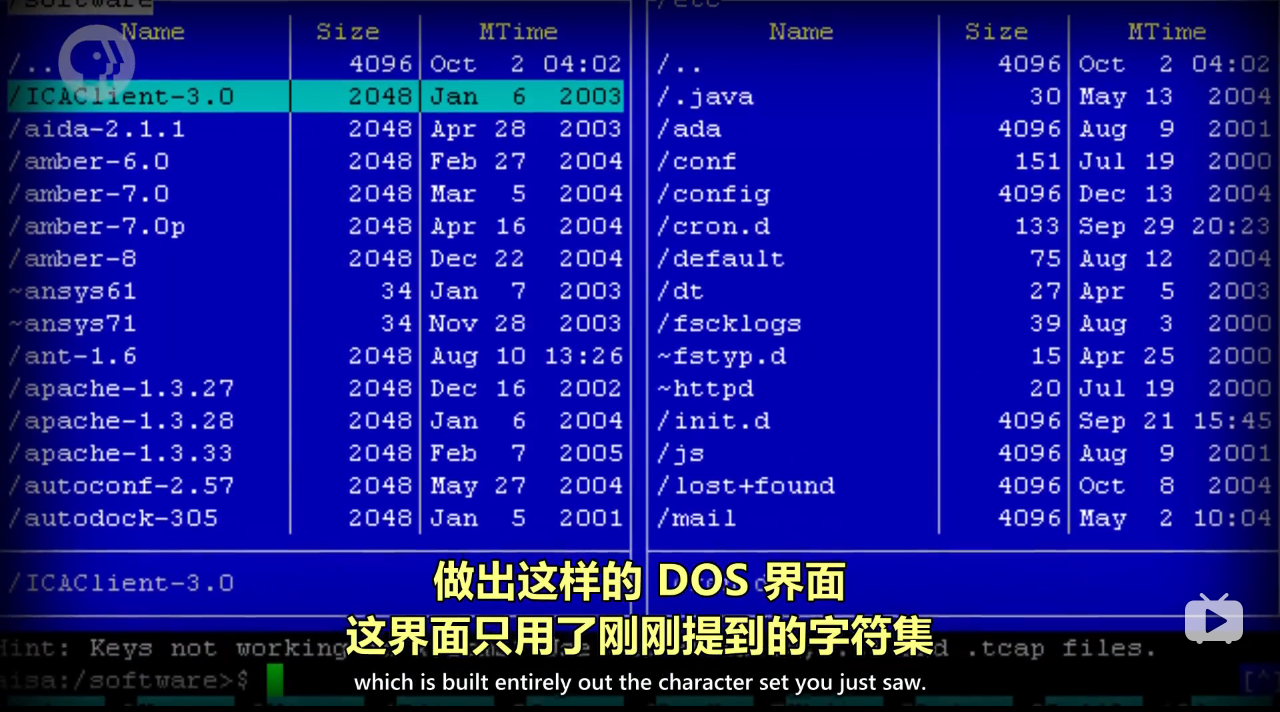23 Screens&2D Graphics
23 屏幕&2D 图形显示
Hi, I'm Carrie Anne, and welcome to Crash Course Computer Science!
嗨,我是 Carrie Anne,欢迎收看计算机科学速成课!
This 1960 PDP-1 is a great example of early computing with graphics.
这台 1960 年的 PDP-1,是一个早期图形计算机的好例子
You can see a cabinet-sized computer on the left,
你可以看到 左边是柜子大小的电脑
an electromechanical teletype machine in the middle,
中间是电传打字机
and a round screen on the right.
右边是一个圆形的屏幕
Note how they're separated.
注意它们是分开的
That's because text-based tasks and graphical tasks were often distinct back then.
因为当时文本任务和图形任务是分开的.
In fact, these early computer screens had a very hard time rendering crisp text, whereas
事实上,早期的屏幕无法显示清晰的文字
typed paper offered much higher contrast and resolution.
而打印到纸上 有更高的对比度和分辨率
The most typical use for early computer screens was to keep track of a program's operation,
早期屏幕的典型用途 是跟踪程序的运行情况
like values in registers.
比如寄存器的值
It didn't make sense to have a teletype machine print this on paper
如果用打印机,一遍又一遍打印出来没有意义
over and over and over again -that'd waste a lot of paper, and it was slow.
不仅费纸而且慢
On the other hand, screens were dynamic and quick to update -perfect for temporary values.
另一方面,屏幕更新很快,对临时值简直完美
Computer screens were rarely considered for program output, though.
但屏幕很少用于输出计算结果,结果一般都打印到纸上
Instead, any results from a computation were typically written to paper
但屏幕很少用于输出计算结果,结果一般都打印到纸上
or some other more permanent medium.
或其它更永久的东西上
But, screens were so darn useful
但屏幕超有用,到1960年代,
that by the early 1960s, people started to use them for awesome things.
人们开始用屏幕做很多酷炫的事情
A lot of different display technologies have been created over the decades,
几十年间出现了很多显示技术
but the most influential, and also the earliest, were Cathode Ray Tubes, or CRT
但最早最有影响力的是 阴极射线管(CRT)
These work by shooting electrons out of an emitter at a phosphor-coated screen.
原理是把电子发射到 有磷光体涂层的屏幕上

When electrons hit the coating, it glows for a fraction of a second.
当电子撞击涂层时 会发光几分之一秒
Because electrons are charged particles,
由于电子是带电粒子,路径可以用磁场控制
their paths can be manipulated with electromagnetic fields.
由于电子是带电粒子,路径可以用磁场控制
Plates or coils are used inside to steer electrons to a desired position,
屏幕内用板子或线圈 把电子引导到想要的位置
both left-right and up-down.
上下左右都行
With this control, there are two ways you can draw graphics.
既然可以这样控制,有 2 种方法绘制图形,
The first option is to direct the electron beam to trace out shapes.
1 引导电子束描绘出形状

This is called Vector Scanning.
这叫"矢量扫描"
Because the glow persists for a little bit, if you repeat the path quickly enough,
因为发光只持续一小会儿,如果重复得足够快
you create a solid image.
可以得到清晰的图像
The other option is to repeatedly follow a fixed path, scanning line by line,
2 按固定路径,一行行来,从上向下,
from top left to bottom right, and looping over and over again.
从左到右,不断重复

You only turn on the electron beam at certain points to create graphics.
只在特定的点打开电子束,以此绘制图形
This is called Raster Scanning.
这叫 "光栅扫描"
With this approach, you can display shapes... and even text... all made of little line segments.
用这种方法,可以用很多小线段绘制形状 甚至文字
Eventually, as display technologies improved,
最后,因为显示技术的发展
it was possible to render crisp dots onto the screen, aka pixels.
我们终于可以在屏幕上显示清晰的点,叫"像素"
The Liquid Crystal Displays, or LCDs,
液晶显示器,简称 LCD
that we use today are quite a different technology.
和以前的技术相当不同
But, they use raster scanning too,
但 LCD 也用光栅扫描,
updating the brightness of little tiny red, green and blue pixels many times a second.
每秒更新多次 像素里红绿蓝的颜色
Interestingly, most early computers didn't use pixels
有趣的是,很多早期计算机不用像素
not because they couldn't physically,
不是技术做不到,
but because it consumed way too much memory for computers of the time.
而是因为像素占太多内存
A 200 by 200 pixel image contains 40,000 pixels.
200像素×200像素的图像,有 40,000 个像素
Even if you use just one bit of data for each pixel,
哪怕每个像素只用一个 bit 表示,
that's black OR white -not grayscale!
代表黑色或白色,连灰度都没有!
the image would consume 40,000 bits of memory.
会占 40,000 bit 内存,
That would have gobbled up more than half of a PDP-1's entire RAM.
比 PDP-1 全部内存的一半还多
So, computer scientists and engineers had to come up with clever tricks to render graphics
所以计算机科学家和工程师,得想一些技巧来渲染图形,
until memory sizes caught up to our pixelicious ambitions.
等内存发展到足够用
Instead of storing tens of thousands of pixels,
所以早期计算机不存大量像素值,
early computers stored a much smaller grid of letters, most typically 80 by 25 characters.
而是存符号,80x25个符号最典型
That's 2000 characters in total.
总共 2000 个字符
And if each is encoded in 8 bits, using something like ASCII,
如果每个字符用 8 位表示,比如用 ASCII
it would consume 16,000 bits of memory for an entire screen full of text,
总共才 16000 位,
which is way more reasonable.
这种大小更合理
To pull this off, computers needed an extra piece of hardware that
为此,计算机需要额外硬件
could read characters out of RAM, and convert them into raster graphics to be drawn onto the screen.
来从内存读取字符,转换成光栅图形,这样才能显示到屏幕上
This was called a character generator, and they were basically the first graphics cards.
这个硬件叫 "字符生成器",基本算是第一代显卡
Inside, they had a little piece of Read Only Memory, a ROM,
它内部有一小块只读存储器,简称 ROM
that stored graphics for each character, called a dot matrix pattern.
存着每个字符的图形,叫"点阵图案"
If the graphics card saw the 8-bit code for the letter "K",
如果图形卡看到一个 8 位二进制,发现是字母 K
then it would raster scan the 2D pattern for the letter K onto the screen, in the appropriate position.
那么会把字母 K 的点阵图案 ,光栅扫描显示到屏幕的适当位置
To do this, the character generator had special access to a portion of a computer's memory
为了显示,"字符生成器" 会访问内存中一块特殊区域,
reserved for graphics, a region called the screen buffer.
这块区域专为图形保留,叫 屏幕缓冲区
Computer programs wishing to render text to the screen
程序想显示文字时,
simply manipulated the values stored in this region,
修改这块区域里的值就行
just as they could with any other data in RAM.
就像他们在RAM中处理其他数据一样。
This scheme required much less memory,
这个方案用的内存少得多,
but it also meant the only thing you could draw was text.
但也意味着 只能画字符到屏幕上
Even still, people got pretty inventive with ASCII art!
即使有这样限制,人们用 ASCII 艺术发挥了很多创意!
People also tried to make rudimentary, pseudo-graphical interfaces out of this basic set of characters
也有人用字符模仿图形界面
using things like underscores and plus signs to create boxes, lines and other primitive shapes.
用下划线和加号来画盒子,线,和其他简单形状
But, the character set was really too small to do anything terribly sophisticated.
但字符集实在太小,做不了什么复杂的事
So, various extensions to ASCII were made that added new semigraphical characters,
因此对 ASCII 进行了各种扩展,加新字符
like IBM's CP437 character set, seen here, which was used in DOS.
比如上图的 IBM CP437 字符集,用于 DOS.
On some systems, the text color and background color could be defined with a few extra bits.
某些系统上,可以用额外的 bit 定义字体颜色和背景颜色
That allowed glorious interfaces like this DOS example,
做出这样的 DOS 界面,
which is built entirely out the character set you just saw.
这界面只用了刚刚提到的字符集

Character generators were a clever way to save memory.
字符生成器 是一种省内存的技巧,
But, they didn't provide any way to draw arbitrary shapes.
但没办法绘制任意形状
And that's important if you want to draw content like electrical circuits, architectural
绘制任意形状很重要,因为电路设计,建筑
plans, maps, and... well pretty much everything that isn't text!
平面图,地图,好多东西都不是文字!
To do this, without resorting to memory-gobbling pixels,
为了绘制任意形状,同时不吃掉所有内存
computer scientists used the vector mode available on CRTs.
计算机科学家用 CRT 上的"矢量模式"
The idea is pretty straightforward: all content to be drawn on screen is defined by a series of lines.
概念非常简单:所有东西都由线组成
There's no text.
没有文字这回事
If you need to draw text, you have to draw it out of lines.
如果要显示文字,就用线条画出来
Don't read between the lines here. There is only lines!
只有线条,没有别的
Got it? Alright, no more word play.
明白了吗?好,我们举个实例吧
I'm drawing the line here.
我在这里画一条 线
Let's pretend this video is a cartesian plane, 200 units wide and 100 tall, with the
假设这个视频是一个 笛卡尔平面,200个单位宽,100个单位高
origin that's the zero-zero point in the upper left corner.
原点 (0,0) 在左上角
We can draw a shape with the following vector commands,
我们可以画形状,用如下矢量命令
which we've borrowed from the Vectrex, an early vector display system.
这些命令来自 Vectrex,一个早期矢量显示系统
First, we reset, which clears the screen,
首先,reset ,这个命令会清空屏幕
moves the drawing point of the electron gun to zero-zero,
把电子枪的绘图点移动到坐标 (0,0)
and sets the brightness of lines to zero.
并把线的亮度设为 0
Then we move the drawing point down to 50 50,
MOVE_TO 50 50,把绘图点移动到坐标 (50,50)
and set the line intensity to 100%.
INTENSITY 100,把强度设为 100
With the intensity up, now we move to 100, 50, then 60, 75 and then back to 50,50.
现在亮度提高了,移动到 (100,50) 然后 (60,75) 然后 (50,50)
The last thing to do is set our line intensity back to 0%.
最后把强度设回 0
Cool! We've got a triangle!
酷,我们画了一个三角形!
This sequence of commands would consume on the order of 160 bits, which is way more efficient
这些命令占 160 bit ,
than keeping a huge matrix of pixel values!
比存一个庞大的像素矩阵更好
Just like how characters were stored in memory and turned into graphics by a character generator,
就像之前的"字符生成器" ,把内存里的字符转成图形一样
these vector instructions were also stored in memory, and rendered to a screen using
这些矢量指令也存在内存中,
a vector graphics card.
通过矢量图形卡画到屏幕上
Hundreds of commands could be packed together, sequentially, in the screen buffer,
数百个命令可以按序存在屏幕缓冲区
and used to build up complex graphics. All made of lines!
画出复杂图形,全是线段组成的!
Because all these vectors are stored in memory, computer programs can update the values freely,
由于这些矢量都在内存中,程序可以更新这些值
allowing for graphics that change over time -Animation!
让图形随时间变化 动画!
One of the very earliest video games, Spacewar!,
最早的电子游戏之一, Spacewar!
was built on a PDP-1 in 1962 using vector graphics.
是 1962 年在 PDP-1 上用矢量图形制作的.
It's credited with inspiring many later games, like Asteroids,
它启发了许多后来的游戏,比如 爆破彗星(Asteroids)
and even the first commercial arcade video game: Computer Space.
甚至第一个商业街机游戏:太空大战
1962 was also a huge milestone because of Sketchpad,
1962 年是一个大里程碑,Sketchpad 诞生
an interactive graphical interface
一个交互式图形界面,用途是计算机辅助设计 (CAD)
that offered Computer-Aided Design -called CAD Software today.
一个交互式图形界面,用途是计算机辅助设计 (CAD)
It's widely considered the earliest example of a complete graphical application.
它被广泛认为是第一个完整的图形程序
And its inventor, Ivan Sutherland, later won the Turing Award for this breakthrough.
发明人 伊万·萨瑟兰 后来因此获得图灵奖
To interact with graphics,
为了与图形界面交互,
Sketchpad used a recently invented input device called a light pen,
Sketchpad 用了当时发明不久的输入设备 光笔
which was a stylus tethered to a computer with a wire.
就是一个有线连着电脑的触控笔
By using a light sensor in the tip, the pen detected the refresh of the computer monitor.
笔尖用光线传感器,可以检测到显示器刷新
Using the timing of the refresh,
通过判断刷新时间,电脑可以知道笔的位置
the computer could actually figure out the pen's position on the screen!
通过判断刷新时间,电脑可以知道笔的位置
With this light pen, and various buttons on a gigantic computer,
有了光笔和各种按钮,
users could draw lines and other simple shapes.
用户可以画线和其他简单形状
Sketchpad could do things like make lines perfectly parallel, the same length, straighten
Sketchpad 可以让线条完美平行,长度相同,
corners into perfect 90 degree intersections, and even scale shapes up and down dynamically.
完美垂直90度,甚至动态缩放
These things that were laborious on paper, a computer now did with a press of a button!
这些在纸上很费力,在计算机上非常简单!
Users were also able to save complex designs they created,
用户还可以保存设计结果,
and then paste them into later designs, and even share with other people.
方便以后再次使用,甚至和其他人分享
You could have whole libraries of shapes, like electronic components and pieces of furniture
你可以有一整个库,里面有电子元件和家具之类的
that you could just plop in and manipulate in your creations.
可以直接拖进来用
This might all sound pretty routine from today's perspective.
从如今的角度来看 好像很普通
But in 1962, when computers were still cabinet-sized behemoths chugging through punch cards,
但在1962年,计算机还是吃纸带的大怪兽,有柜子般大小
Sketchpad and light pens were equal parts eye opening and brain melting.
Sketchpad 和光笔让人大开眼界
They represented a key turning point in how computers could be used.
它们代表了人机交互方式的关键转折点
They were no longer just number crunching math machines that hummed along behind closed doors.
电脑不再是关在门后 负责算数的机器了
Now, they were potential assistants, interactively augmenting human tasks.
可以当助手 帮人类做事
The earliest computers and displays with true pixel graphics emerged in the late 1960s.
最早用真正像素的计算机和显示器,出现于 1960 年代末
Bits in memory directly "mapped" to pixels on the screen,
内存中的位(Bit) 对应屏幕上的像素
what are called bitmapped displays.
这叫 位图显示
With full pixel control, totally arbitrary graphics were possible.
现在我们可以绘制任意图形了
You can think of a screen's graphics as a huge matrix of pixel values .
你可以把图形想成一个巨大像素值矩阵
As before,
就像之前
computers reserve a special region of memory for pixel data, called the frame buffer.
计算机把像素数据存在内存中一个特殊区域,叫"帧缓冲区"
In the early days, the computer's RAM was used,
早期时,这些数据存在内存里,
but later systems used special high speed Video RAM, or VRAM,
后来存在高速视频内存里,简称 VRAM
which was located on the graphics card itself for high speed access.
VRAM 在显卡上,这样访问更快,
This is how it's done today.
如今就是这样做的.
On an 8-bit grayscale screen, we can set values from 0 intensity, which is black,
在 8 位灰度屏幕上,我们可用的颜色范围是 0 强度(黑色)
to 255 intensity, which is white.
到 255 强度(白色)
Well actually, it might be green... or orange, as many early displays couldn't do white.
其实更像绿色或橙色,因为许多早期显示器不能显示白色
Let's pretend this video is a really low resolution bitmapped screen,
我们假设 这个视频在低分辨率的位图屏幕上
with a resolution of 60 by 35 pixels.
分辨率 60x35像素
If we wanted to set the pixel at 10 10 to be white,
如果我们想把 (10,10) 的像素设为白色,
we could do it with a piece of code like this.
可以用这样的代码
If we wanted to draw a line, let's say from 30, 0 to 30, 35, we can use a loop, like so.
如果想画一条线 假设从(30,0)到(30,35),可以用这样一个循环
.And this changes a whole line of pixels to white.
把整列像素变成白色
If we want to draw something more complicated, let's say a rectangle,
如果想画更复杂的图形,比如矩形,
we need to know four values.
那么需要四个值
The X and Y coordinate of its starting corner, and its width and height.
1 起始点X坐标;2 起始点Y坐标;3 宽度;4 高度
So far, we've drawn everything in white, so let's specify this rectangle to be grey.
目前只试了白色,这次画矩形试下灰色
Grey is halfway between 0 and 255, so that's a color value of 127.
灰色介于0到255中间,所以我们用 127 (255/2=127.5)
Then, with two loops C one nested in the other,
然后用两个循环,一个套另一个
so that the inner loop runs once for every iteration of the outer loop,
这样外部每跑一次,内部会循环多次,可以画一个矩形
we can draw a rectangle.
这样外部每跑一次,内部会循环多次,可以画一个矩形
When the computer executes our code as part of its draw routine, it colors in all the
计算机绘图时会用
pixels we specified.
指定的颜色
Let's wrap this up into a "draw rectangle function", like this:
我们来包装成 "画矩形函数",就像这样:
Now, to draw a second rectangle on the other side of the screen, maybe in black this time,
假设要在屏幕的另一边 画第二个矩形,这次可能是黑色矩形
we can just call our rectangle drawing function. Voila!!
可以直接调用 "画矩形函数", 超棒!
Just like the other graphics schemes we've discussed,
就像之前说的其他方案
programs can manipulate pixel data in the frame buffer, creating interactive graphics.
程序可以操纵"帧缓冲区"中的像素数据,实现交互式图形
Pong time!
乒乓球时间!
Of course, programmers aren't wasting time writing drawing functions from scratch.
当然,程序员不会浪费时间从零写绘图函数,
They use graphics libraries with ready-to-go functions
而是用预先写好的函数来做,
for drawing lines, curves, shapes, text, and other cool stuff.
画直线,曲线,图形,文字等
Just a new level of abstraction!
一层新抽象!
The flexibility of bitmapped graphics opened up a whole new world of possibilities for
位图的灵活性,为交互式开启了全新可能,
interactive computing, but it remained expensive for decades.
但它的高昂成本持续了十几年
As I mentioned last episode, by as late as 1971,
上集提到,1971 年,
it was estimated there were around 70,000 electro-mechanical teletype machines
整个美国也只有大约 7 万个电传打字机
and 70,000 terminals in use, in the United States.
和 7 万个终端
Amazingly, there were only around 1,000 computers in the US that had interactive graphical screens.
令人惊讶的是,只有大约 1000 台电脑有交互式图形屏幕
That's not a lot!
这可不多!
But the stage was set helped along by pioneering efforts like Sketchpad and Space Wars
Sketchpad 和 太空大战 这样的先驱 ,推动了图形界面发展
for computer displays to become ubiquitous,
帮助普及了计算机显示器,
and with them, the dawn of graphical user interfaces,
由此,图形界面的曙光初现
which we'll cover in a few episodes!
接下来讲图形界面
I'll see you next week.
下周见